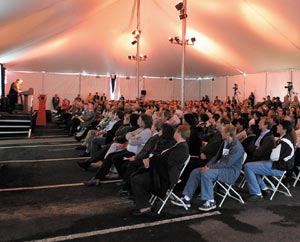
The latest reincarnation of the famous SPEAR storage ring – SPEAR3 – was formally opened at a dedication ceremony at the Stanford Linear Accelerator Center (SLAC) on 29 January. The new synchrotron light source incorporates the latest technology – much of it pioneered at the Stanford Synchrotron Radiation Laboratory (SSRL) and SLAC – to make it competitive with the best synchrotron sources in the world. Some 2000 scientists will use the new machine’s extremely bright X-ray light each year in studies ranging from materials science to structural biology.
Thirty years ago SSRL was among the first laboratories in the world to use synchrotron-produced X-rays for studying matter at atomic and molecular scales, and the first to offer beam time to a broad user community of scientists from academic, industry and government laboratories (based on peer-reviewed proposals). The original SPEAR ring, built for particle-physics research at SLAC, yielded several major discoveries in the field and also provided fertile ground for innovating synchrotron techniques.

SPEAR3 is a complete rebuild and upgrade of the SPEAR2 ring, with all the magnets, vacuum and radiofrequency systems having been replaced. The new ring also has the capacity for eight to 10 more beam lines, with associated experimental stations. A gift of $14.2 million (~€11.2 million) from the Gordon and Betty Moore Foundation to the California Institute of Technology will allow scientists at Caltech and Stanford University to collaborate on the building of a designated beam line for structural molecular-biology research. The quality and brightness of SPEAR3’s X-ray light is well suited to studying complex biological systems.
The SPEAR3 project was completed on time and to the budget of $58 million (~€46 million). The first electron beams circulated in the new ring in mid-December 2003 and the first experiments are scheduled to begin in March this year.








